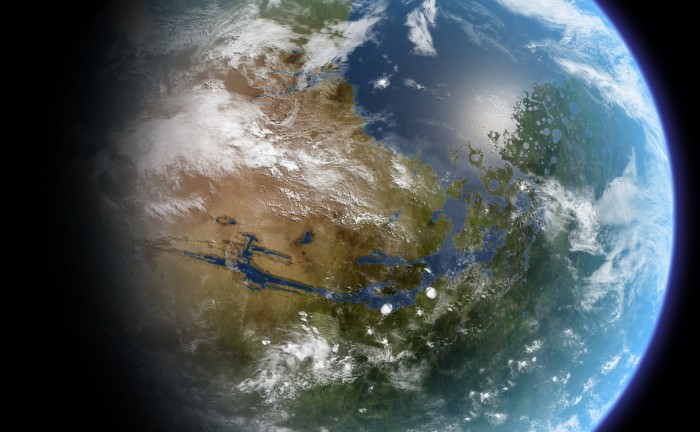
Guide to Space, Mars, Terraforming
How Do We Terraform Mars?
As part of our continuing “Definitive Guide To Terraforming” series, Universe Today is happy to present our guide to terraforming Mars. At present, there are several plans to put astronauts and ever settlers on the Red Planet. But if we really want to live there someday, we’re going to need to do a complete planetary renovation. What will it take?
Despite having a very cold and very dry climate – not to mention little atmosphere to speak of – Earth and Mars have a lot in common. These include similarities in size, inclination, structure, composition, and even the presence of water on their surfaces. Because of this, Mars is considered a prime candidate for human settlement; a prospect that includes transforming the environment to be suitable to human needs (aka. terraforming).
That being said, there are also a lot of key differences that would make living on Mars, a growing preoccupation among many humans (looking at you, Elon Musk and Bas Lansdorp!), a significant challenge. If we were to live on the planet, we would have to depend rather heavily on our technology. And if we were going to alter the planet through ecological engineering, it would take a lot of time, effort, and megatons of resources!
The challenges of living on Mars are quite numerous. For starters, there is the extremely thin and unbreathable atmosphere. Whereas Earth’s atmosphere is composed of 78% nitrogen, 21% oxygen, and trace amounts of other gases, Mars’ atmosphere is made up of 96% carbon dioxide, 1.93% argon and 1.89% nitrogen, along with trace amounts of oxygen and water.
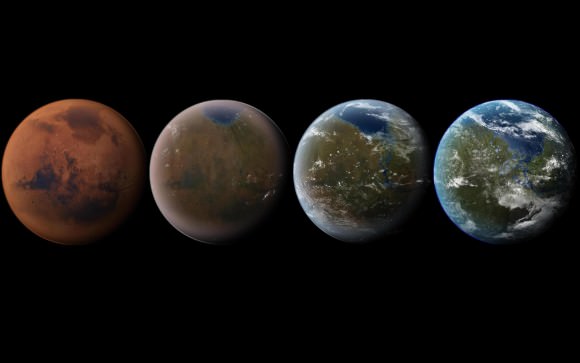
Artist’s impression of the terraforming of Mars, from its current state to a livable world. Credit: Daein Ballard
Mars’ atmospheric pressure also ranges from 0.4 – 0.87 kPa, which is the equivalent of about 1% of Earth’s at sea level. The thin atmosphere and greater distance from the Sun also contributes to Mars’ cold environment, where surface temperatures average 210 K (-63 °C/-81.4 °F). Add to this the fact that Mars’ lacks a magnetosphere, and you can see why the surface is exposed to significantly more radiation than Earth’s.
On the Martian surface, the average dose of radiation is about 0.67 millisieverts (mSv) per day, which is about a fifth of what people are exposed to here on Earth in the course of a year. Hence, if humans wanted to live on Mars without the need for radiation shielding, pressurized domes, bottled oxygen, and protective suits, some serious changes would need to be made. Basically, we would have to warm the planet, thicken the atmosphere, and alter the composition of said atmosphere.
Examples In Fiction:
In 1951, Arthur C. Clarke wrote the first novel in which the terraforming of Mars was presented in fiction. Titled The Sands of Mars, the story involves Martian settlers heating up the planet by converting Mars’ moon Phobos into a second sun, and growing plants that break down the Martians sands in order to release oxygen.
In 1984, James Lovelock and Michael Allaby wrote what is considered by many to be one of the most influential books on terraforming. Titled The Greening of Mars, the novel explores the formation and evolution of planets, the origin of life, and Earth’s biosphere. The terraforming models presented in the book actually foreshadowed future debates regarding the goals of terraforming.

Kim Stanley Robinson’s Red Mars Trilogy. Credit: variety.com
In 1992, author Frederik Pohl released Mining The Oort, a science fiction story where Mars is being terraformed using comets diverted from the Oort Cloud. Throughout the 1990s, Kim Stanley Robinson released his famous Mars Trilogy – Red Mars, Green Mars, Blue Mars – which centers on the transformation of Mars over the course of many generations into a thriving human civilization.
In 2011, Yu Sasuga and Kenichi Tachibana produced the manga series Terra Formars, a series that takes place in the 21st century where scientists are attempting to slowly warm Mars. And in 2012, Kim Stanley Robinson released 2312, a story that takes place in a Solar System where multiple planets have been terraformed – which includes Mars (which has oceans).
Proposed Methods:
Over the past few decades, several proposals have been made for how Mars could be altered to suit human colonists. In 1964, Dandridge M. Cole released “Islands in Space: The Challenge of the Planetoids, the Pioneering Work“, in which he advocated triggering a greenhouse effect on Mars. This consisted of importing ammonia ices from the outer Solar System and then impacting them on the surface.
Since ammonia (NH³) is a powerful greenhouse gas, its introduction into the Martian atmosphere would have the effect of thickening the atmosphere and raising global temperatures. As ammonia is mostly nitrogen by weight, it could also provide the necessary buffer gas which, when combined with oxygen gas, would create a breathable atmosphere for humans.
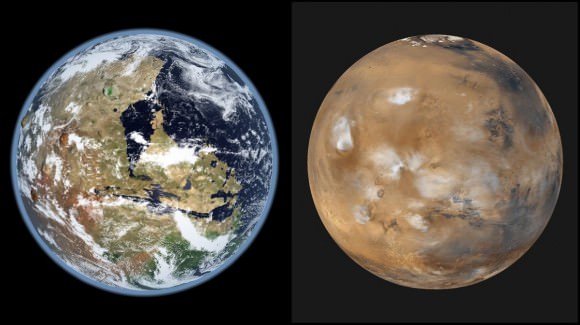
Scientists were able to gauge the rate of water loss on Mars by measuring the ratio of water and HDO from today and 4.3 billion years ago. Credit: Kevin Gill
Another method has to do with albedo reduction, where the surface of Mars would be coated with dark materials in order to increase the amount of sunlight it absorbs. This could be anything from dust from Phobos and Deimos (two of the darkest bodies in the Solar System) to extremophile lichens and plants that are dark in color. One of the greatest proponents for this was famed author and scientist, Carl Sagan.
In 1973, Sagan published an article in the journal Icarus titled “Planetary Engineering on Mars“, where he proposed two scenarios for darkening the surface of Mars. These included transporting low albedo material and/or planting dark plants on the polar ice caps to ensure they absorbed more heat, melted, and converted the planet to more “Earth-like conditions”.
In 1976, NASA officially addressed the issue of planetary engineering in a study titled “On the Habitability of Mars: An Approach to Planetary Ecosynthesis“. The study concluded that photosynthetic organisms, the melting of the polar ice caps, and the introduction of greenhouse gases could all be used to create a warmer, oxygen and ozone-rich atmosphere.
In 1982, Planetologist Christopher McKay wrote “Terraforming Mars”, a paper for the Journal of the British Interplanetary Society. In it, McKay discussed the prospects of a self-regulating Martian biosphere, which included both the required methods for doing so and ethics of it. This was the first time that the word terraforming was used in the title of a published article, and would henceforth become the preferred term.
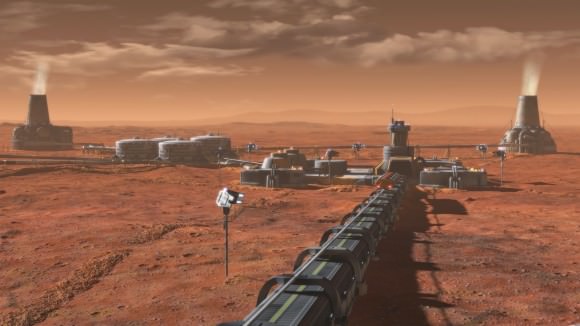
Artist’s concept of a possible Mars terraforming plant, warming the planet through the introduction of hydrocarbons. Credit: nationalgeographic.com
This was followed in 1984 by James Lovelock and Michael Allaby’s book, The Greening of Mars. In it, Lovelock and Allaby described how Mars could be warmed by importing chlorofluorocarbons (CFCs) to trigger global warming.
In 1993, Mars Society founder Dr. Robert M. Zubrin and Christopher P. McKay of the NASA Ames Research Center co-wrote “Technological Requirements for Terraforming Mars“. In it, they proposed using orbital mirrors to warm the Martian surface directly. Positioned near the poles, these mirrors would be able to sublimate the CO ice sheet and contribute to global warming.
The use of fluorine compounds – “super-greenhouse gases” that produce a greenhouse effect thousands of times stronger than CO² – has also been recommended as a long term climate stabilizer. In 2001, a team of scientists from the Division of Geological and Planetary Sciences at Caltech made these recommendations in the “Keeping Mars warm with new super greenhouse gases“.
Where this study indicated that the initial payloads of fluorine would have to come from Earth (and be replenished regularly), it claimed that fluorine-containing minerals could also be mined on Mars. This is based on the assumption that such minerals are just as common on Mars (being a terrestrial planet) which would allow for a self-sustaining process once colonies were established.

NASA’s Curiosity Mars rover has detected fluctuations in methane concentration in the atmosphere, implying that it is added and removed all the time. (Image Credit: NASA/JPL-Caltech/SAM-GSFC/Univ. of Michigan)
Importing methane and other hydrocarbons from the outer Solar System – which are plentiful on Saturn’s moon Titan – has also been suggested. There is also the possibility of in-situ resource utilization, thanks to the Curiosity rover’s discovery of a “tenfold spike” of methane that pointed to a subterranean source. If these sources could be mined, methane might not even need to be imported.
More recent proposals include the creation of sealed biodomes that would employ colonies of oxygen-producing cyanobacteria and algae on Martian soil. In 2014, the NASA Institute for Advanced Concepts (NAIC) program and Techshot Inc. began work on this concept, which was named the “Mars Ecopoiesis Test Bed“. In the future, the project intends to send small canisters of extremophile photosynthetic algae and cyanobacteria aboard a rover mission to test the process in a Martian environment.
If this proves successful, NASA and Techshot intend to build several large biodomes to produce and harvest oxygen for future human missions to Mars – which would cut costs and extend missions by reducing the amount of oxygen that has to be transported. While these plans do not constitute ecological or planetary engineering, Eugene Boland (chief scientist of Techshot Inc.) has stated that it is a step in that direction:
“Ecopoiesis is the concept of initiating life in a new place; more precisely, the creation of an ecosystem capable of supporting life. It is the concept of initiating “terraforming” using physical, chemical and biological means including the introduction of ecosystem-building pioneer organisms… This will be the first major leap from laboratory studies into the implementation of experimental (as opposed to analytical) planetary in situ research of greatest interest to planetary biology, ecopoiesis and terraforming.”

The “greening of Mars” would be a multi-tiered process, involving the importation of gases and terrestrial organisms to convert the planet over the course of many generations. Credit: nationalgeographic.com
Potential Benefits:
Beyond the prospect for adventure and the idea of humanity once again embarking on an era of bold space exploration, there are several reasons why terraforming Mars is being proposed. For starters, there is concern that humanity’s impact on planet Earth is unsustainable, and that we will need to expand and create a “backup location” if we intend to survive in the long run.
This school of though cites things like the Earth’s growing population – which is expected to reach 9.6 billion by mid-century – as well as the fact that by 2050, roughly two-thirds of the world’s population is expected to live in major cities. On top of that, there is the prospect of severe Climate Change, which – according to a series of scenarios computed by NASA – could result in life becoming untenable on certain parts of the planet by 2100.
Other reasons emphasize how Mars lies within our Sun’s “Goldilocks Zone” (aka. “habitable zone), and was once a habitable planet. Over the past few decades, surface missions like NASA’s Mars Science Laboratory (MSL) and its Curiosity rover have uncovered a wealth of evidence that points to flowing water existing on Mars in the deep past (as well as the existence of organic molecules).
In addition, NASA’s Mars Atmosphere and Volatile EvolutioN Mission (MAVEN) (and other orbiters) have provided extensive information on Mars’ past atmosphere. What they have concluded is that roughly 4 billion years ago, Mars had abundant surface water and a thicker atmosphere. However, due to the loss of Mars’ magnetosphere – which may have been caused by a large impact or rapid cooling of the planet’s interior – the atmosphere was slowly stripped away.
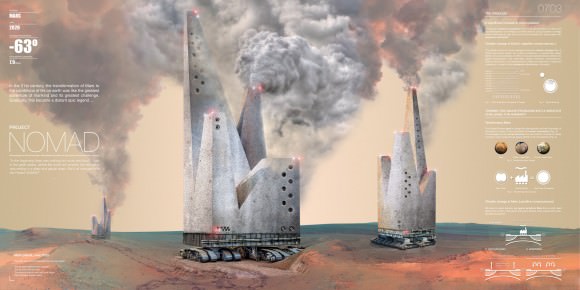
Project Nomad, a concept for the 2013 Skyscraper Competition that involved mobile factory-skyscrapers terraforming Mars. Credit: evolo.com/A.A. Sainz/J.R. Nuñez/K.T. Rial
Ergo, if Mars was once habitable and “Earth-like”, it is possible that it could be again one day. And if indeed humanity is looking for a new world to settle on, it only makes sense that it be on one that has as much in common with Earth as possible. In addition, it has also been argued that our experience with altering the climate of our own planet could be put to good use on Mars.
For centuries, our reliance on industrial machinery, coal and fossil fuels has had a measurable effect Earth’s environment. And whereas this has been an unintended consequence of modernization and development here on Earth; on Mars, the burning of fossil fuels and the regular release of pollution into the air would have a positive effect.
Other reasons include expanding our resources base and becoming a “post-scarcity” society. A colony on Mars could allow for mining operations on the Red Planet, where both minerals and water ice are abundant and could be harvested. A base on Mars could also act as a gateway to the Asteroid Belt, which would provide us with access to enough minerals to last us indefinitely.
Challenges:
Without a doubt, the prospect of terraforming Mars comes with its share of problems, all of which are particularly daunting. For starters, there is the sheer amount of resources it would take to convert Mars’ environment into something sustainable for humans. Second, there is the concern that any measure undertaken could have unintended consequences. And third, there is the amount of time it would take.
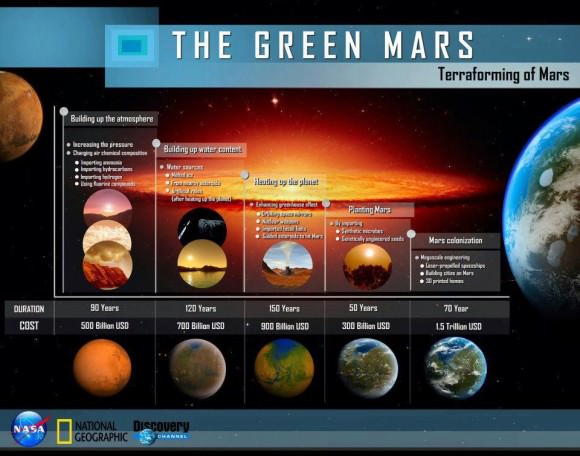
Infographic showing a cost-estimate and time frame for the terraforming of Mars. Credit: NASA/National Geographic Channel/Discovery Channel
For example, when it comes to concepts that call for the introduction of greenhouse gases to trigger warming, the quantities required are quite staggering. The 2001 Caltech study, which called for the introduction of fluorine compounds, indicated that sublimating the south polar CO² glaciers would require the introduction of approximately 39 million metric tons of CFCs into Mars’ atmosphere – which is three times the amounts produced on Earth between 1972 and 1992.
Photolysis would also begin to break down the CFCs the moment they were introduced, which would necessitate the additional of 170 kilotons every year to replenish the losses. And last, the introduction of CFCs would also destroy the Martian any ozone that was produced, which would undermine efforts to shield to surface from radiation.
Also, the 1976 NASA feasibility study indicated that while terraforming Mars would be possible using terrestrial organisms, it also recognized that the time-frames called for would be considerable. As it states in the study:
“No fundamental, insuperable limitation of the ability of Mars to support a terrestrial ecology is identified. The lack of an oxygen-containing atmosphere would prevent the unaided habitation of Mars by man. The present strong ultraviolet surface irradiation is an additional major barrier. The creation of an adequate oxygen and ozone-containing atmosphere on Mars may be feasible through the use of photosynthetic organisms. The time needed to generate such an atmosphere, however, might be several millions of years.”
The study goes on to state that this could be drastically reduced by creating extremophile organisms specifically adapted for the harsh Martian environment, creating a greenhouse effect and melting the polar ice caps. However, the amount of time it would take to transform Mars would still likely be on the order of centuries or millennia.
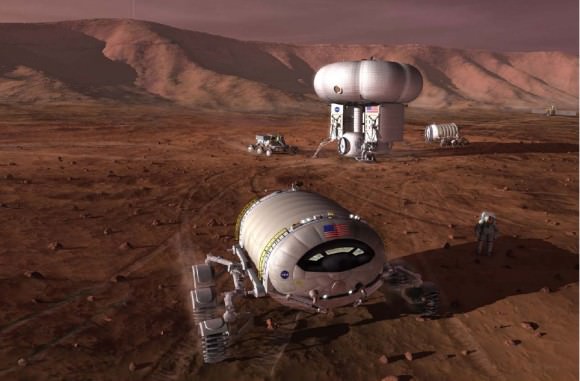
Artist’s concept for a NASA manned-mission to Mars (Human Exploration of Mars Design Reference Architecture 5.0, Feb 2009). Credit: NASA
And of course, there is the problem of infrastructure. Harvesting resources from other planets or moons in the Solar System would require a large fleet of space haulers, and they would need to be equipped with advanced drive systems to make the trip in a reasonable amount of time. Currently, no such drive systems exist, and conventional methods – ranging from ion engines to chemical propellants – are neither fast or economical enough.
To illustrate, NASA’s New Horizons mission took more than 11 years to get make its historic rendezvous with Pluto in the Kuiper Belt, using conventional rockets and the gravity-assist method. Meanwhile, the Dawn mission, which relied relied on ionic propulsion, took almost four years to reach Vesta in the Asteroid Belt. Neither method is practical for making repeated trips to the Kuiper Belt and hauling back icy comets and asteroids, and humanity has nowhere near the number of ships we would need to do this.
On the other hand, going the in-situ route – which would involve factories or mining operations on the surface to release CO², methane or CFC-containing minerals into the air – would require several heavy-payload rockets to get all the machinery to the Red Planet. The cost of this would dwarf all space programs to date. And once they were assembled on the surface (either by robotic or human workers), these operations would have to be run continuously for centuries.
There is also several questions about the ethics of terraforming. Basically, altering other planets in order to make them more suitable to human needs raises the natural question of what would happen to any lifeforms already living there. If in fact Mars does have indigenous microbial life (or more complex lifeforms), which many scientists suspect, then altering the ecology could impact or even wipe out these lifeforms. In short, future colonists and terrestrial engineers would effectively be committing genocide.
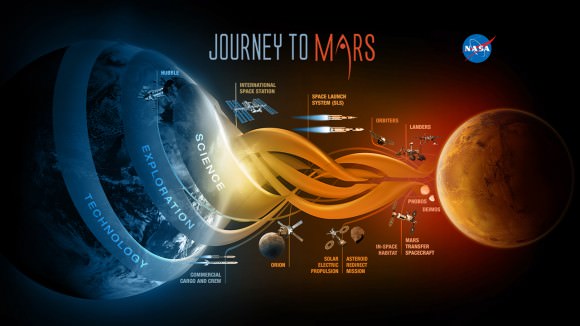
NASA’s Journey to Mars. NASA is developing the capabilities needed to send humans to an asteroid by 2025 and Mars in the 2030s. Credit: NASA/JPL
Given all of these arguments, one has to wonder what the benefits of terraforming Mars would be. While the idea of utilizing the resources of the Solar System makes sense in the long-run, the short-term gains are far less tangible. Basically, harvested resources from other worlds is not economically viable when you can extract them here at home for much less. And given the danger, who would want to go?
But as ventures like MarsOne have shown, there are plenty of human beings who are willing to make a one-way trip to Mars and act as Earth’s “first-wave” of intrepid explorers. In addition, NASA and other space agencies have been very vocal about their desire to explore the Red Planet, which includes manned missions by the 2030s. And as various polls show, public support is behind these endevours, even if it means drastically increased budgets.
So why do it? Why terraform Mars for human use? Because it is there? Sure. But more importantly, because we might need to. And the drive and the desire to colonize it is also there. And despite the difficulty inherent in each, there is no shortage of proposed methods that have been weighed and determined feasible.In the end, all that’s needed is a lot of time, a lot of commitment, a lot of resources, and a lot of care to make sure we are not irrevocably harming life forms that are already there.
But of course, should our worst predictions come to pass, we may find in the end that we have little choice but to make a home somewhere else in the Solar System. As this century progresses, it may very well be Mars or bust!
We have written many interesting articles about terraforming here at Universe Today. Here’s The Definitive Guide To Terraforming, Could We Terraform the Moon?, Should We Terraform Mars?, How Do We Terraform Venus?, and Student Team Wants to Terraform Mars Using Cyanobacteria.
We’ve also got articles that explore the more radical side of terraforming, like Could We Terraform Jupiter?, Could We Terraform The Sun?, and Could We Terraform A Black Hole?
Astronomy Cast also has good episodes on the subject, like Episode 96: Humans to Mar, Part 3 – Terraforming Mars
For more information, check out Terraforming Mars at NASA Quest! and NASA’s Journey to Mars.
And if you like the video, come check out our Patreon page and find out how you can get these videos early while helping us bring you more great content!

